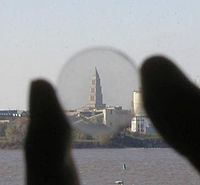
Photo from wikipedia
Abstract Down conversion involving emission of two near-infrared photons for one ultraviolet photon absorbed was achieved in Nd3+ and Yb3+ co-doped transparent YAG glass ceramics. Upon excitation of Nd3+ ions… Click to show full abstract
Abstract Down conversion involving emission of two near-infrared photons for one ultraviolet photon absorbed was achieved in Nd3+ and Yb3+ co-doped transparent YAG glass ceramics. Upon excitation of Nd3+ ions with an ultraviolet photon at 355 nm, Yb3+ ions emitted two near-infrared photons at 980 nm through an efficient two-step energy transfer process from Nd3+ to Yb3+. The mechanisms of the two-step energy transfer were verified by spectra and lifetime measurements, and the optimal quantum efficiency achieved was as high as 185.0%, which was close to the theoretical value of 200%. Therefore, the Yb3+ emission centered at 980 nm was efficiently enhanced and responded to the strongest absorption of crystalline silicon solar cells. The development of near-infrared down conversion transparent glass ceramics would allow an increase of the energy efficiency of the silicon solar cells.
Journal Title: Journal of Luminescence
Year Published: 2018
Link to full text (if available)
Share on Social Media: Sign Up to like & get
recommendations!